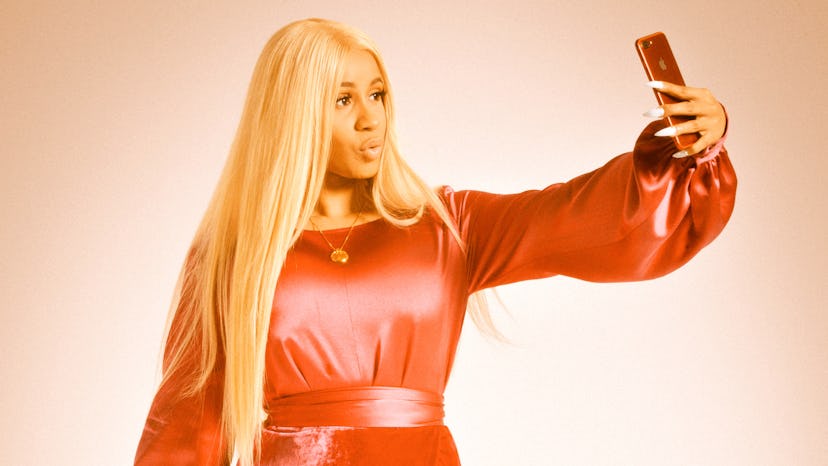Is TikTok the Next Big Beauty Space?
What the VSCO, e-girls and goth GFs popping up in your feed mean for a changing beauty sphere.

This summer, Euphoria‘s wildly innovative makeup looks made it clear that teens are taking more risks than ever with beauty. Buzzy brands such as Fenty and Glossier Play embraced diversity and self-acceptance on social media. A resurgence of goth GFs and Juggalos, coupled with the rise of VSCO girls—i.e “the Tumblr girl of 2019”—and of course the infamous e-girls (and boys) reflected Gen Z’s backlash to Instagram’s homogenous beauty trends of the past decade. With YouTube makeup guru drama rocking the internet and influencer engagement at an all-time low, not to mention the fact that Instagram is debating doing away with likes all together, the fatigue of a bloated beauty sphere has set in. Enter TikTok, a microcosm as weird as it is addictive.
You may not know exactly what TikTok is, but you’ve no doubt felt the short-form video platform’s ripple through pop culture. Comprised of user-generated, 15-second lipsyncing clips, it’s “Yee Yee Juice” challenge propelled Lil Nas X’s ‘Old Town Road’ from viral meme to the longest-running number 1 in Billboard history. It breathed new life into Mariah Carey’s 2005 hit ‘Obsessed’, garnering the attention of the singer, who even attempted the viral dance herself. From Insane Clown Posse to Ashley O to Avril Lavigne to Peppa Pig, countless artists have found success in TikTok’s short-form videos. But aside from the popular app’s near alchemical ability to turn songs into gold—or three times platinum in Lil Nas X’s case—it has another, potentially more lucrative market: the beauty industry.
Experimentation is what makes TikTok, well, tick. Anyone who lived through the aughts will notice that e-girl beauty is rife with scene kid influence. Balayage and blowouts are scarce: instead, hordes of teens are testing out coloring their hair shades of electric blue, jet black, tangerine, and baby pink—even Billie Eilish dyed her roots slime green in July. Kardashian-worthy contouring has been replaced by a dusting of anime-inspired blush across the bridge of one’s nose. Sure, you’ll still see a cut crease or razor-sharp cat-eye, but it’s accompanied by tiny eyeliner hearts on both cheeks.
Just a few of the beauty looks found across Instagram and TikTok. Clockwise: @addyyrae, @rottenpeachcorpse, @eve.frsr, and @aasshh.jpg.
On the other end of the spectrum, Emma Chamberlain-emulating VSCO girls are all about the natural look, complete with top knots in a scrunchie, Carmex or Burts Bee’s lip balm and liberal amounts of Mario Badescu’s Rose Water Toner.
However, at its core, TikTok’s greatest virtue is its accessibility: it’s full of DIY makeup tips, dupes, and how-to vids. Can’t afford Fenty’s Body Lava? Just mix baby oil with a crushed up highlighter. Don’t want to shell out for Glossier’s Cloud Paint? There’s a hack for that too.
Recently, users have been changing themselves into a “‘00s babe/baddie”—to the tune of ‘Oops I Did It Again’, naturally—complete with frosted lipstick, icy blue shadow, and hair that would do Paris Hilton proud. Independent of Gen Z beauty trends, TikTok has become a burgeoning community for amateur makeup artists, drag queens, casual cosplayers and more to show off their skill.
Courtesy of TikTok.
It’s not surprising that a handful of makeup brands have already set their sights on TikTok’s 500 million-plus monthly users: open the app and you’re greeted by a high-impact Too Faced ad before you start scrolling. Huda Beauty, Jeffree Star and Fenty all have accounts, with the latter seeming to task its interns to push out content every few days. In theory, it’s a smart move: teens have some disposable income to spend on the product du jour. Marc Anthony True Professional saw a 60% uptick in sales after their Strictly Curl Lotion went viral in a TikTok challenge earlier this year.
The app just celebrated its 1 year anniversary this week, and it’s anyone’s guess whether it will have any staying power, especially if one looks to its predecessor, Vine (may it rest in peace). While TikTok may be the new frontier of Gen Z content creation—and by extension advertising—with any digital platform companies run the risk of having their brands misaligned by user-generated content they can’t control, not to mention maturity, bullying and exploitation concerns due to its large teenage customer base.
Will TikTok usurp Instagram as a premiere beauty destination? In a space that prides itself on spontaneity and self-depreciation, luxury beauty advertisers may struggle to find purchase. At the moment, the app’s greatest asset is its ability to spawn viral trends and memes—if brands can keep up. Still, as far as bite-sized beauty content goes, TikTok is here to fill that Vine-shaped hole left in your heart.